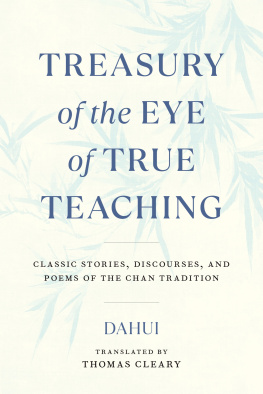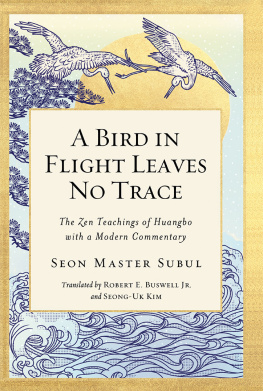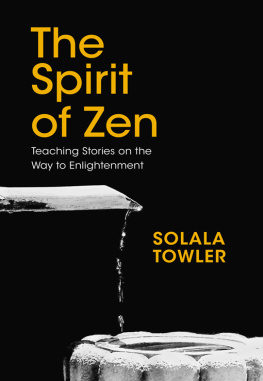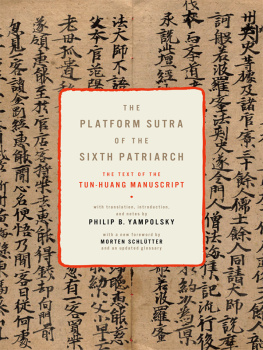Zen Teaching of
Instantaneous Awakening
being the teaching of the Zen Master
Hui Hai, known as the Great Pearl
Rendered into English by
John Blofeld
A complete translation of the
Tun Wu Ju Tao Yao Mn Lun
and the Tsung Ching Record
Foreword by
Charles Luk
Buddhist Publishing Group
Totnes
Buddhist Publishing Group
PO Box 173, Totnes, Devon TQ9 9AE, UK
First published by Rider & Company an imprint of the Century Hutchinson Publishing Group Limited 1962 Second edition 1969 Reprinted 1973, 1974
This edition by the Buddhist Publishing Group 1987 reprinted 1992, 1995, 2007, 2015
Published by the kind permission of the Buddhist Society, London.
Copyright John Blofeld 1962, 1969, 1987
Copyright Buddhist Publishing Group 1995, 2007, 2015
All rights reserved
No part of this book may be reproduced or stored in any form or by any means, electronic, digital, or mechanical, including technologies now known or later developed, without written permission from the publisher.
British Library Cataloguing in Publication Data
Hui Hai
[The Zen teaching of Hui Hai on sudden illumination]. The Zen teaching of instantaneous awakening: being the teaching of the Zen master, Hui Hai, known as the Great Pearl.
1. Zen Buddhism
l. [The Zen teaching of Hui Hai on sudden illumination].
ll. Title lll. Hui Hai.
Tsung Ching record
294.3927 BQ9265.4
ISBN 978-0946672035
Cover photo: Lisa Daix
Table of Contents
Respectfully dedicated to that true Buddhist, learned scholar, and author and translator of many valuable Chan texts,
Charles Luk
Publishers note
Where generalizations have been made using the male gender in the original translation, the neutral form has been adopted throughout this volume to bring it into line with modern practice. For example: Men who seek realization has been altered to Those who seek realization .. , and so forth. Various small passages and notes have also been removed from the Foreword and the Translators Introduction related to general Buddhist understanding in the West and to historical facts which are now very much out-of-date. Apart from these minor changes, the texts stand in their original form.
BPG
1995
Foreword
T he ancients had their unexcelled ways of teaching which seem strange to the people of this modern age of materialism, not only in the West but also in the East. For the human mind is now more concerned with material than with spiritual values; it seeks only the satisfaction of its ever-increasing desires though these are the very cause of our sufferings and it casts away its own treasure house, which is its paradise of eternal bliss. So long as we allow our minds to discriminate and to grasp at illusions, the ancient teaching will seem strange, even stupid and silly, to us. However, if we succeed in disengaging our minds from externals that is if we stop all our discriminating and discerning the profundity of that teaching will become apparent to us, for it inculcates not only theory but also that practice which will give immediate results in the sphere of reality; for a teaching cannot be regarded as complete unless it gives the practical method of reaching the ultimate goal. When the Great Pearl preached his Dharma of Instantaneous Awakening, he taught its doctrine , its aim , its substance and its function ; thus his teaching consists not only of the right interpretation and correct understanding of theory but also of the practical realization of substance and function , which are the two essentials of complete enlightenment. In other words, he taught the right Dharma which is immanent in everyone and which does not come from outside.
The Masters numerous quotations from Mahayana sutras, together with his unsurpassed interpretations and comments, show that all great masters read the whole Tripitaka before or after their enlightenment, and refutes the unjustifiable contention that sutras can be dispensed with in the Transmission of Mind introduced into China by the Twenty-Eighth Patriarch, Bodhidharma.
The Great Pearl urged his listeners not to let their minds abide anywhere and at the same time to keep from illusory nonabiding, so that a state of all-pervading purity and cleanness would appear of itself. And even this pure state should not be clung to, in order to release the mind from all remaining relativities and thereby attain realization of the patient endurance of the uncreate (anutpattikadharmakshanti) which is an essential condition of complete enlightenment. Thus, his instruction followed exactly the same pattern of the Dharma as laid down by the Buddha who said in the Sutra of Complete Enlightenment that his disciples should keep themselves again and again from all illusions, including the illusory idea of keeping from them, so as to wipe out all traces of subject and object until nothing further remained to be avoided for only then could bodhi appear in full.
Therefore, Part One of this book gives the Mahayana instruction for self-realization of mind, for perception of self-nature and consequent attainment of Buddhahood. And Part Two contains the dialogues between the Great Pearl and those who came to him for instruction. If we seriously follow this teaching and practise self-cultivation, beginning with the mind as the starting point, there is every possibility that we shall succeed in reaching the same mental states as those described by the Great Pearl in his twenty-eight-line gatha.
Charles Luk
(Upasaka Lu Kuan Y)
Hong Kong
Translators Introduction
Invocation
Homage to my teachers! Homage to the three precious ones the Buddha, Dharma and Sangha! Homage to that which dwells within us all!
The birth of this translation
While passing the winter of 1959-60 in Kalimpong, a flower-girt townlet in the Himalayan foothills, I spent several hours a day seated at the feet of one or other of those saintly and learned monks who had recently fled their Tibetan monasteries in search of a haven where they could preach the dharma without restraint or fear. Alas, my ignorance of Tibetan made me woefully dependent upon the services of that kind and patient Tibetan scholar and linguist, John Driver, who gave most generously of his time. Even so, I could not banish my sorrow at being so near and yet so cut off from monks with such precious knowledge to impart. Then one day when I was gazing disconsolately at Kanchenjungas majestic snowscape, the thought came to me that I was wasting valuable time in regrets as useless to myself as to others. Knowing nothing of Tibetan or Sanskrit, I did at least know something of Chinese Buddhist texts; my Zen Teaching of Huang Po , though far from being a masterpiece of translation, was even then affording some people an insight into the marvellous workings of an enlightened mind. So why not try again?
Thereupon, my thoughts flew back to a temple secluded in a long, low valley in West China where, during the Second World War, I had gone from my post at our embassy in Chungking to recuperate from illness. Today I do not even remember the temples name, but I shall not easily forget what befell me there. It is strange (and no doubt a symptom of our need for books such as the Great Pearls) how quickly the most delicious pleasures pall. Living in that peaceful temple, with nothing to do all day long beyond reading, sipping tea with friendly monks and gazing out at the beautiful pine-crowned ridges to either side of the fertile valley, I presently found myself bored! Beauty and idleness, to which years of hard work and a month of illness had made me look forward with all my heart, had all too quickly lost their charm. The aged monk-librarian, noticing with his shrewd old eyes my need for distraction, took me to spend a morning with him in the library a large pavilion almost as big as the main shrine hall of the temple. Inside, I found most of it occupied not by books, but by thousands of delicately incised boards of the kind formerly used for printing Chinese texts. Many of them were centuries old and bore vertical rows of characters so exquisitely formed that I was able to pass several happy hours handling and admiring them; but my state of health had left me weak and presently I felt the need to seek my bedroom, which opened off the shrine hall on the other side of the courtyard. Just as I turned to go, the old monk smilingly placed in my hands a copy of one of the ancient texts block-printed from the boards I had been examining.








